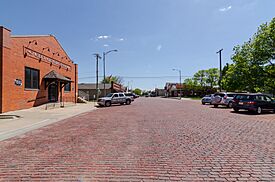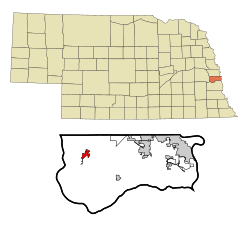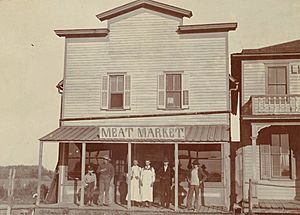Gretna, Nebraska facts for kids
Quick facts for kids
Gretna, Nebraska
|
|
|---|---|

Downtown looking south on McKenna Avenue, May 2017
|
|

Location of Gretna, Nebraska
|
|
| Country | United States |
| State | Nebraska |
| County | Sarpy |
| Founded | Summer of 1886 |
| Incorporated | July 10, 1889 |
| Area | |
| • Total | 7.049 sq mi (18.257 km2) |
| • Land | 6.951 sq mi (18.003 km2) |
| • Water | 0.097 sq mi (0.251 km2) |
| Elevation | 1,112 ft (339 m) |
| Population
(2020)
|
|
| • Total | 5,083 |
| • Estimate
(2023)
|
9,054 |
| • Density | 1,302/sq mi (502.8/km2) |
| Time zone | UTC−6 (Central (CST)) |
| • Summer (DST) | UTC−5 (CDT) |
| ZIP Code |
68028
|
| Area code(s) | 402 and 531 |
| FIPS code | 31-20260 |
| GNIS feature ID | 2394248 |
| Sales tax | 7.5% |
Gretna is a city located in Sarpy County, Nebraska, United States. It is a growing community with a population of over 9,000 people as of 2022. Gretna is known for its friendly atmosphere and strong schools.
Contents
History of Gretna
Gretna began to form in the summer of 1886. This was shortly after the Burlington Railroad built a new train line. The line connected Omaha and Ashland.
Before Gretna, there was a busy trading post called Forest City. It had been around since 1856. Forest City was located about 2.5 miles southwest of where Gretna is now. But the new railroad did not go through Forest City. This meant its time as a main center was ending.
Today, you can still find signs of old Forest City. There is a cemetery called Holy Sepulchre. It is a little east of where the town used to be. Also, a homestead from 1886, originally owned by the Schnack Family, still stands. Important families in Forest City's early days included the Schnacks, William Langdon, John Thomas, and John Conner.
In 1887, the Lincoln Land Company saw the potential of the area. They surveyed and planned the town site of Gretna. To "plat" a town means to draw out its streets and lots. The village officially became a town on July 10, 1889. The name "Gretna" was chosen because it reminded early settlers of Gretna Green in Scotland. Many of these first settlers came from that part of the world.
Geography of Gretna
Gretna covers a total area of about 7 square miles (18.257 square kilometers). Most of this area is land. A small part, about 0.097 square miles (0.251 square kilometers), is water.
Population Changes in Gretna
| Historical population | |||
|---|---|---|---|
| Census | Pop. | %± | |
| 1890 | 255 | — | |
| 1900 | 466 | 82.7% | |
| 1910 | 484 | 3.9% | |
| 1920 | 491 | 1.4% | |
| 1930 | 477 | −2.9% | |
| 1940 | 482 | 1.0% | |
| 1950 | 438 | −9.1% | |
| 1960 | 745 | 70.1% | |
| 1970 | 1,557 | 109.0% | |
| 1980 | 1,609 | 3.3% | |
| 1990 | 2,249 | 39.8% | |
| 2000 | 2,355 | 4.7% | |
| 2010 | 4,441 | 88.6% | |
| 2020 | 5,083 | 14.5% | |
| 2023 (est.) | 9,054 | 103.9% | |
| U.S. Decennial Census 2020 Census |
|||
Gretna has seen a lot of growth in its population over the years. In 1890, there were only 255 people living there. By 2020, the population had grown to 5,083 people. Recent estimates for 2023 show the population is now around 9,054. This shows Gretna is a fast-growing city.
Gretna's Population in 2020
According to the 2020 census, Gretna had 5,083 people. There were 2,020 households and 1,293 families. The population density was about 743 people per square mile.
About 25.3% of the people were under 18 years old. About 13.2% were 65 years or older. The average age in Gretna was 36.2 years. For every 100 females, there were about 83.5 males.
Gretna's Population in 2010
In the 2010 census, Gretna had 4,441 people. There were 1,594 households and 1,139 families. The population density was about 2,115 people per square mile.
About 31.7% of residents were under 18 years old. About 12.4% were 65 years or older. The average age in the city was 34.5 years. The population was almost evenly split between males (49.0%) and females (51.0%).
Education in Gretna
Gretna is known for its strong school system. The city's schools have grown a lot over the years.
School Funding and Bonds
Gretna Public Schools has used "bond issues" to build new buildings. A bond issue is like a loan that the school district takes out. Property owners in the area help pay back these loans through taxes. Gretna has one of the higher school bond tax rates in Nebraska. Only Bennington and Elkhorn have slightly higher rates.
Gretna Public Schools System
The first school building in Gretna was built in 1898. It was updated in 1908, and a gym was added in 1936. In 1958, the Gretna Public Schools District became much larger. It now covers about 70 square miles.
The school district includes:
- Seven elementary schools
- Two middle schools
- Two high schools
Here is a list of the schools:
- Aspen Creek Elementary
- Aspen Creek Middle School
- Falling Waters Elementary
- Gretna East High School
- Gretna Elementary
- Gretna High School
- Gretna Middle School
- Harvest Hills Elementary
- Palisades Elementary
- Squire John Thomas Elementary
- Whitetail Elementary
Notable People from Gretna
- Andy Janovich, a professional football player.
See also
 In Spanish: Gretna (Nebraska) para niños
In Spanish: Gretna (Nebraska) para niños


